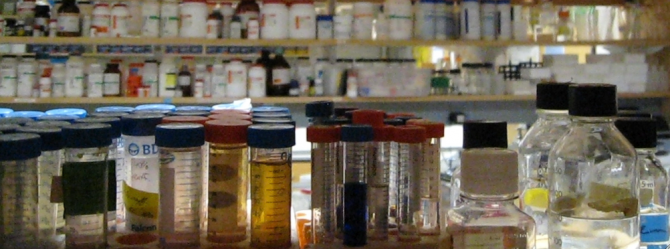Difference between revisions of "20.109(S08):Protein-level analysis (Day6)"
From Course Wiki
(→Part 1: Day 2 of ELISA) |
|||
| Line 23: | Line 23: | ||
-oral: note to keep preparing (or suggest making presentation outline, but never handed in) | -oral: note to keep preparing (or suggest making presentation outline, but never handed in) | ||
| + | |||
| + | ==Reagent List== | ||
Revision as of 15:22, 31 January 2008
Contents
Introduction
Protocols
Part 1: Day 2 of ELISA
- Begin by washing your samples. (Check the protocol on Day 5 for a refresher.) This time do four washes instead of only two - you don’t want to amplify the signal from any primary antibody that isn’t firmly bound to your samples.
- When you are ready, ask the teaching faculty for some alkaline-phosphatase labeled secondary antibody (this should be diluted at the last minute). Add 100 μL of diluted antibody per well. Incubate for 90 min (at room temperature), and work on Part 2 of today's protocol.
- Your final wash step should be very thorough because it again precedes an amplification step. To reduce non-specific binding and improve your signal-to-noise ratio, do four careful washes. In the next step, we are adding the substrate for the alkaline phosphatase enzyme.
- Ask the teaching faculty for development buffer and a pNPP (p-nitrophenyl phosphate) pellet. Vortex until the pellet is fully dissolved in the buffer, then add 100 μL of development solution to each well. Cover your plate with aluminum foil now!
- Every few minutes, check if the samples are becoming yellow. This will most likely take 10-15 minutes, but may happen sooner.
- The top 1-3 samples in the standards may become bright yellow, while the bottom 1-2 samples may appear very pale yellow. Once again, we have a signal:noise issue. If you wait too long, more samples will become saturated (bright), and the results will be meaningless. If you don’t wait long enough, you may miss a positive but low result.
- Use your best judgment! Ideally, look for a couple of your samples (not just the standards) to have developed some colour. However, note that some sample may not have measurable protein content (particularly supernatants). Feel free to ask the teaching faculty for advice.
- When your samples are ready, add 100 μL of Stop Solution (0.4 M NaOH). A member of the teaching faculty will take the plates to BPEC and read them in the absorbance plate reader at 420 nm.
Part 2: Continue ImageJ analysis (optional)
Today you can finish any analysis that you did not get to on Day 5.
For next time
-oral: note to keep preparing (or suggest making presentation outline, but never handed in)
